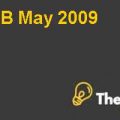Profitability Case Study Solution
Income statement:
Definition:
Income statement is one of the three viable financial statements uses to report the ongoing performance of a company in a financial term by evaluating the revenue and expenses over the specified accounting period. Normally small and medium enterprises prepare income statement on monthly basis. While large firms and few medium size organizations chalk out it on quarterly and yearly basis. As it tells the company about its financial performance in term of gain and loss it is also known as profit and loss summary. Further it is recognized as statement of expense and revenue because it blatantly describe revenue generated as well as expenses incurred by a firm during a particular time period. It is made on accrual base of accounting.
Purpose:
The purpose of the income statement is to determine that whether the organization make profit or loss after paying all the expenses and cost during a given period of time. It shows the efficiency of the organizations. It help the organization to figure out that which factor in the income statement provide the best results as well as which factors has to be controlled. Income statement should be relevant, reliable, comparable and according to the accounting standards.Income statement is prepared into two methods:
Single Step Income Statement:
In this method of income statement from the total revenues total expenses are subtracted to reach the bottom line.
Multiple Step Income Statement:
In this method of income statement multiple steps are taken to reach the bottom line such as it starts from the revenue from which cost of goods sold is subtracted to earn the gross profit of the organization, after that all the other expenses related to production are subtracted to get the net profit of the organization.
Income statement is very important for the analysis point of view as well as provide useful information about the future decisions, company performances and firm financial health. There are two types of reporting standards:
- GAAP (Generally Accepted Accounting Principle)
- IFRS (International Financial Reporting Standards)
Benefits of Income Statements:
- Help in understanding the business profitability.
- Help in decision making on the basis of past performances.
- Provide better insight about the organizations operations.
- Support in analysis and comparison with competitors.
- It is used in analysis, evaluation and forecasting and improving the firm performance
Drawbacks of Income Statement:
- As it is made on accrual basis so the net profit is not actual cash flow.
- Net profit should be manipulated by adding any one of event activity
- Inventory system use by the organizations also manipulate the net profit of the organization such as some companies use LIFO system while other use FIFO inventory system.
- The depreciation method are also used by the organization in order to manipulate the net earnings of the company.
- Some organizations manipulate its earning in order to save itself from tax paying.
The Cash flow Statement:
Cash flow statement refers to all the cash and cash equivalents activities. A cash flow statement provides the data related all the activities that generate the cash inflows from its internal operations as well as from the external sources during a given period of time. It provides the data related to all the activities that generate the cash out flows to pay its cost and expenses incurred by the operations of the company during a given period of time. The cash flow statement is composed in three categories:
- Cash flow from operating activity.
- Cash flow from investing activity.
- Cash flow from financing activity.
The cash flow statement is different from other financial statements (profit and loss statement, balance sheet) of the organization because financial statements are made on accrual basis which means that it shows all the future receivables as well as non-cash items while cash flow statement includes only that items against which physical exchange of cash occurs. It provides the information about the cash position of organizations that how much the organization is holding cash, how much it should pay or incurred in operations and how much it generate from its operations.
It is linked to the growth and success of the organizations. It is necessary for the organizations that they must have to produce sufficient cash flows from its operations that it cover all the expenses and cost of the company. It provide the insight about the efficiency of the company’s management that how efficiently it generates cash from its operations. It is helpful in future forecasting, future long term and short term investment for the organizations. As it show the cash position of the organization so it also measures the riskiness of the organization.
Cash flow statement has two methods i.e. direct and indirect methods. It is the key performance indicator in the success of the organization. It provide valuable insight to the lender about the company ability to repay its debt. It also provide information to the investor about the organization future potential of generating cash.
Cash Flows from Operations:
It includes all the activities related to operations such as selling buying related to the merchandises and other products and services. Cash flows from operations shows the operational efficiency of an organization. The cash flow from operations could be founded by using two different methods;
- Direct Method: Considering the data from income statement.
- Indirect Method: Considering the data related to Balance sheet.
Formula:
Direct Method:
Cash Flow from Operations = Net Income + Non-Cash Expenses
Indirect Method:
Cash Flow from Operations = Net Income ± (Increase) Decrease in Current Assets ± (Decrease) Increase in Current Liabilities
Cash Flows from Investing:
It includes all the activities related to the buying and selling of the fixed assets. The cash flows from investing activities shows the net investments of a firm in a particular year.
Formula:
Cash Flow from Investing Activities = Cash Proceeds from Sale of Assets – Purchase of Fixed Assets
Cash Flows from Financing:
It includes all the activities related to the stock, investors, debtors and other activities related to the long term liability and equity.
Formula:
Cash Flow from Financing Activities = Cash Proceeds from issuance of stock + Debt issued ± Interest (Paid) Received – Treasury Stock – Principal Payment
This is just a sample partical work. Please place the order on the website to get your own originally done case solution.
How We Work?
Just email us your case materials and instructions to order@thecasesolutions.com and confirm your order by making the payment here










